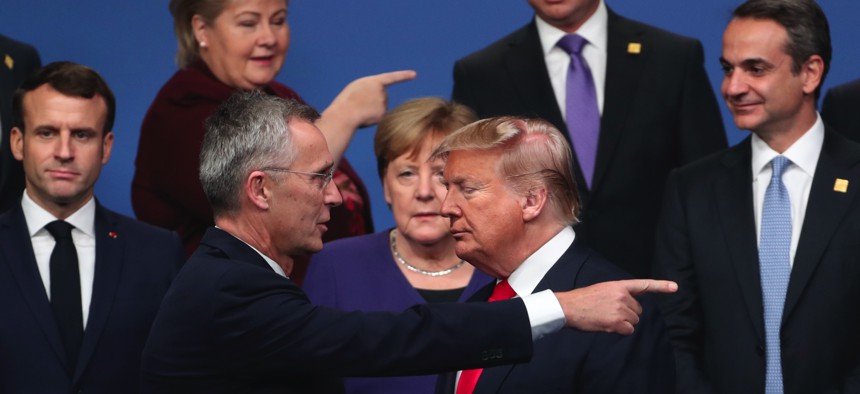
NATO Secretary General Jens Stoltenberg, center front left, speaks with U.S. President Donald Trump, center front right, after a group photo at a NATO leaders meeting in England, Wednesday, Dec. 4, 2019. AP / Francisco Seco
Under Trump, the US Has Become a Leading Source of Global Instability
The country is now a known unknown, increasing the risk of crises from the Middle East to East Asia to Central America, a new survey suggests.
The end of the year brings myriad rankings: the best books, movies, and so on. In Washington, D.C., the lists tend to be of a more ... sobering variety.
For years, the Council on Foreign Relations has asked hundreds of U.S. government officials and foreign-policy experts to rate the potential security crises that could most threaten the United States in the coming year. Typically the respondents have focused on the world’s hot spots. More top of mind this year, it seems, was the destabilizing force at home.
Yes, there is “rising anxiety about the state of the world,” Paul Stares, who oversees CFR’s annual poll, told me. And that anxiety, he added, “probably has a lot to do with the policies of the Trump administration,” and the “turbulence” and “instability” it has created around the globe.
Over the past several years, as Donald Trump took the reins of American statecraft from Barack Obama, the United States as an actor in the world morphed from a known quantity to an unknown one to a “known unknown,” Stares observed, channeling Donald Rumsfeld.
Related: 10 Ways America’s Situation in the Middle East Will Get Worse
Related: Egypt’s President Is Crushing Dissent — and Fueling ISIS
Related: The US Has Supported Lebanon’s Corrupt Ruling Class Long Enough
“In the early months of [Trump’s] administration, there was some hope—call it wishful thinking—that he would become more appreciative of the U.S. role in the world, its contributions to international stability and peace and so on, and would essentially then follow the long-standing playbook of U.S. foreign policy,” said Stares, an expert on conflict prevention. “But that hasn’t been true. So we now are more prepared [for the] unexpected, or more cautious about how we project future U.S. policy.”
Stares noted that the forthcoming survey, conducted in November, yielded more scenarios in the highest category of risk than in any of the previous 11 years. And he argued that the specific scenarios respondents slotted into the survey’s top-priority tier—those that would have a major impact on U.S. interests and were thought to have at least an even chance of occurring in 2020—reflected “as much concern and uncertainty about U.S. actions as about the actions of others.”
For example, Trump’s precipitous (and now semi-reversed) military withdrawalfrom Syria and America’s Kurdish partners in the fight against the Islamic State there, along with his on-again, off-again peace talks with the Taliban in Afghanistan, likely contributed to respondents’ worries about escalating violence among warring factions in Syria and in Afghanistan. Another top worry was an armed confrontation between Iran and the United States or one of its allies, no doubt informed by the Trump administration’s maximum-pressure campaign on Iran and Tehran’s escalating retaliatory actions. Those surveyed raised alarms about a coming crisis on the Korean peninsula involving North Korean tests of nuclear-capable long-range missiles as a result of Trump’s collapsing nuclear negotiations with Kim Jong Un. They also anticipated increased migration from El Salvador, Guatemala, and Honduras because of deteriorating conditions in those countries, a concern Stares attributed to the Trump administration’s policy of “essentially trying to wall ourselves off from those problems without really addressing the root causes.”
Other top risks surfaced by the survey—a cyberattack on crucial U.S. infrastructure, such as 2020 electoral systems; a major terrorist attack orchestrated by a foreign terrorist group; a military conflict between China and its neighbors over disputed territory in the South China Sea; a serious clash between Russia and Ukraine—were not directly related to Trump’s policies. But still, Stares said, there were indirect connections. The president, for example, has downplayed the threat of foreign election interference, jeopardized the fight against ISIS with his troop pullout from Syria, raised tensions with China about trade that could spill over into other domains, and cast doubt on his commitment to U.S. allies that has emboldened adversaries such as Vladimir Putin and Xi Jinping, who hope to exploit “the diminished presence and engagement of the United States.”
In a separate forthcoming CFR report, Stares found that Trump has in the first three years of his presidency already weathered 14 foreign-policy crises (defined as an external event that triggers high-level deliberations about using the U.S. military), just one shy of the average since 1989 for a four-year presidential term. These have included North Korean nuclear and long-range missile tests, Syrian chemical-weapons attacks, Iranian military aggression, and skirmishes between the nuclear-armed states of India and Pakistan. But Trump has entered into no new wars, whereas all of his predecessors since George H. W. Bush had launched military interventions by this point in their presidency. Stares told me, however, that this state of affairs can’t simply be explained by Trump’s restraint in using military force.
Within their first term, George H. W. Bush had Saddam Hussein’s invasion of Kuwait; Bill Clinton, the Yugoslav wars; George W. Bush, the 9/11 terrorist attacks; and Barack Obama, the Arab Spring and its ugly aftermath. Trump hasn’t confronted a crisis that poses “an obvious threat to U.S. interests” and “would require a major deployment of U.S. forces, particularly in a new part of the world,” Stares told me. But if this year’s survey results are any guide, that test could yet come.
NEXT STORY: Add Economic Policy to Deterrence Planning




